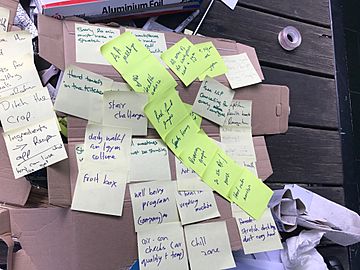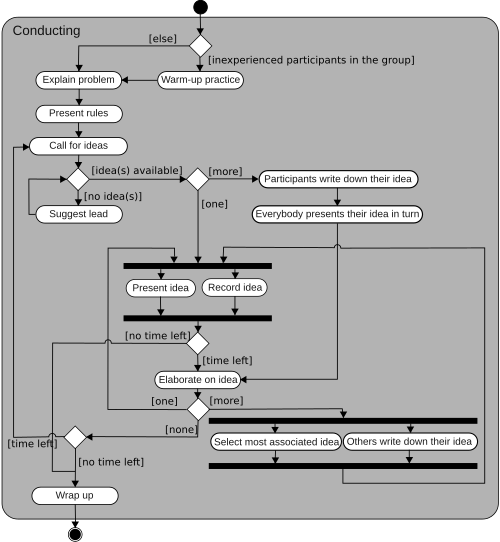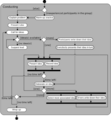Brainstorming facts for kids
Brainstorming is a creative way for a group of people to find solutions to a problem. It involves gathering many ideas from everyone in the group.
When you brainstorm, people meet to create new ideas and solutions. They do this by sharing thoughts freely without worrying about being judged. Everyone suggests as many new ideas as they can. All ideas are written down without criticism. After the session, the ideas are looked at more closely.
The idea of brainstorming became popular thanks to Alex Faickney Osborn. He wrote about it in his book Applied Imagination in 1953.
Contents
History of Brainstorming
In 1939, an advertising expert named Alex F. Osborn started looking for new ways to solve problems creatively. He was frustrated because his employees struggled to come up with new ideas for ad campaigns on their own.
So, he began holding group meetings where everyone thought together. He noticed a big improvement in how many and how good the ideas were. He first called this process organized ideation. But later, the people in the groups started calling them "brainstorm sessions." They thought of it as using their "brain to storm a problem."
Osborn wrote about creative thinking during this time. He first mentioned brainstorming in his book How to Think Up (1942). He then explained his method in more detail in Your Creative Power (1948).
One of Osborn's main tips was to give everyone in the group a clear problem to solve. This should happen before the brainstorming session begins. He also said the problem should be simple. It should focus on one specific goal. Brainstorming works best for clear problems. It might not be as good for very complex issues.
Osborn's Method for Ideas
Two Main Principles
Alex F. Osborn said two main ideas help create lots of good ideas:
- Don't judge ideas right away.
- Aim for a large number of ideas.
Four Important Rules
Based on these two principles, Osborn set up four rules for brainstorming. These rules help people feel more comfortable sharing. They also help create more ideas and boost the group's creativity.
Here are the four rules:
- Go for quantity: Try to get as many ideas as possible. The more ideas you have, the better chance you'll find a really good and new solution.
- Don't criticize: When brainstorming, don't judge any ideas. Instead, focus on building on or adding to ideas. Save criticism for later. When people don't fear judgment, they feel free to share unusual ideas.
- Welcome wild ideas: Encourage strange or "wild" ideas. These can come from looking at things in new ways. Sometimes, the wildest ideas lead to the best solutions.
- Combine and improve ideas: Think of it like "1+1=3." This means you should try to connect and build on each other's ideas. This can lead to even better solutions.
When to Use Brainstorming
Osborn said brainstorming should focus on one specific question. He believed that trying to solve many questions at once was not effective.
Also, the problem should need new ideas, not just a decision. For example, brainstorming is great for thinking of names for a new product. But it's not for making a simple "yes" or "no" decision.
How Groups Work
Osborn imagined groups of about 12 people. These groups should include both experts and beginners. Everyone is encouraged to share wild and unexpected ideas. No idea gets criticized or discussed during the session. The group simply lists ideas that might lead to a solution. They don't judge if the ideas are possible yet. That judgment comes later.
Different Ways to Brainstorm
Nominal Group Technique
In this method, people write down their ideas without showing them. Then, a leader collects all the ideas. The group then votes on each idea. A simple way to vote is by a show of hands. This step is called distillation.
After voting, the top ideas might go back to the group. Or they might go to smaller groups for more brainstorming. For example, one small group might work on the color of a product. Another might work on its size. Each group then shares their ideas with the whole group for ranking. Sometimes, ideas that were put aside earlier might be brought back.
Group Passing Technique
In a circular group, each person writes down one idea. Then, they pass the paper to the next person. That person adds their thoughts to the idea. This continues until everyone gets their original paper back. By then, each idea will likely have many added thoughts.
Another way is to create an "idea book." The problem is written on the first page. The first person writes their ideas. Then, they pass the book to the next person. The next person can add new ideas or build on the previous ones. This goes on until everyone has added their thoughts. Later, a meeting is held to discuss the ideas in the book. This method takes longer. But it gives people more time to think deeply.
Individual Brainstorming
Individual brainstorming is when you brainstorm by yourself. This often includes techniques like free writing (writing whatever comes to mind). It can also involve word association or drawing a mind map. A mind map is a visual way to take notes and connect your thoughts. Individual brainstorming is very helpful for creative writing. It has even been shown to be better than traditional group brainstorming for some tasks.
Question Brainstorming
This method involves brainstorming questions instead of answers. The goal is not to find immediate solutions. This technique can encourage more people to join in. This is because they don't have to provide solutions. The answers to these questions can then help plan future actions. Once you have a list of questions, you might need to decide which ones are most important. This helps find the best solution in an organized way.
Tips for Better Brainstorming
Groups can make their brainstorming sessions better in several ways:
- Avoid face-to-face groups sometimes: Meeting in person can sometimes make it harder to share ideas. People might forget ideas or worry about what others think.
- Follow the rules: Make sure everyone sticks to the brainstorming rules. Give feedback if someone breaks them. Breaking the rules can lead to less creative ideas.
- Listen to everyone: People often focus on their own ideas. But brainstorming needs you to listen to others. You can encourage this by asking people to list or repeat others' ideas.
- Mix individual and group work: One good method is "brainwriting." Here, people write their ideas on paper. Then they pass it to others who add their own ideas.
- Take breaks: Allow quiet time during discussions. This gives everyone time to think.
- Don't rush: Give plenty of time to complete the task. Rushing might produce more ideas quickly. But the quality is often lower than if you take more time.
- Stay focused: Keep working on the task, even if ideas are slow to come.
- Have a leader: A good leader can guide the session. They can motivate people, correct mistakes, and keep track of all the ideas. They also make sure ideas are available to everyone.
Challenges in Group Brainstorming
Sometimes, group brainstorming might not create more ideas than people working alone. Here are some reasons why:
- Production blocking: Only one person can speak at a time. This means others might forget their ideas. Or they might not share them because they think they are no longer important. This can also stop a person's flow of thought.
- Evaluation worry: People might worry about how others in the group are judging their ideas. This can make them less likely to share. This is especially true if a leader is watching the group. People with high social anxiety might feel more nervous.
- Social matching: People in a group might change how many ideas they share. They might try to match what others are doing. If they think they are sharing more than others, they might slow down.
- Illusion of group success: Group members often think their group is doing better than it really is. They might work less because of this. This can happen because:
- People might accidentally think others' ideas are their own.
- They compare themselves to those who share fewer ideas. This makes them feel like they are doing well.
- Group brainstorming can "feel" more successful. This is because people rarely feel stuck when others are sharing ideas.
Electronic Brainstorming
 Electronic brainstorming (EBS) uses computers to help groups brainstorm. This can be done through emails or special websites. There are also computer programs designed just for brainstorming.
Electronic brainstorming (EBS) uses computers to help groups brainstorm. This can be done through emails or special websites. There are also computer programs designed just for brainstorming.
Early systems used computer networks in special meeting rooms. Group members would type their ideas into a computer at the same time. The software would collect all the ideas into a list. This list could be shown on a big screen. The ideas could even be anonymous. These systems also helped with organizing ideas. They could remove duplicates or discuss important ideas. Later systems used the internet. This allowed people to brainstorm over longer times and from different places.
EBS can replace face-to-face brainstorming. It can make things more efficient by removing travel time. It also removes the need to take turns speaking. EBS also helps with some problems of in-person meetings. For example, it reduces "production blocking." This is when people forget ideas while waiting to speak. It also reduces "evaluation worry." This is the concern about how others are judging you. These benefits get bigger with larger groups.
A great thing about EBS is that all ideas can be saved electronically. They can be looked at later for more thought. EBS also lets much larger groups brainstorm than traditional methods.
Computer-supported brainstorming can solve some challenges of old methods. Ideas can be "pooled" automatically. So, people don't have to wait their turn. Some programs show all ideas as they are created. Seeing the ideas flow can help people think more. Their attention stays on the ideas, without distractions like facial expressions. EBS has been shown to produce more ideas. It also helps people focus on others' ideas better. This is because people try not to repeat ideas already shared.
Studies show that EBS can create more unique ideas. It can also lead to better quality ideas. However, people in EBS groups sometimes report being less happy with the process.
Some web-based brainstorming lets people post comments anonymously. This also allows people to log in over a few days or weeks. This gives them time to think before sharing ideas. This method is often used in developing new products.
Some downsides of EBS include getting too many ideas at once. Also, people might compare how many ideas they produce to others.
Images for kids
See also
 In Spanish: Lluvia de ideas para niños
In Spanish: Lluvia de ideas para niños
- 6-3-5 Brainwriting
- Affinity diagram
- Group concept mapping
- Eureka effect
- Lateral thinking
- Mass collaboration
- Nominal group technique
- Thinking outside the box
- What? Where? When?





